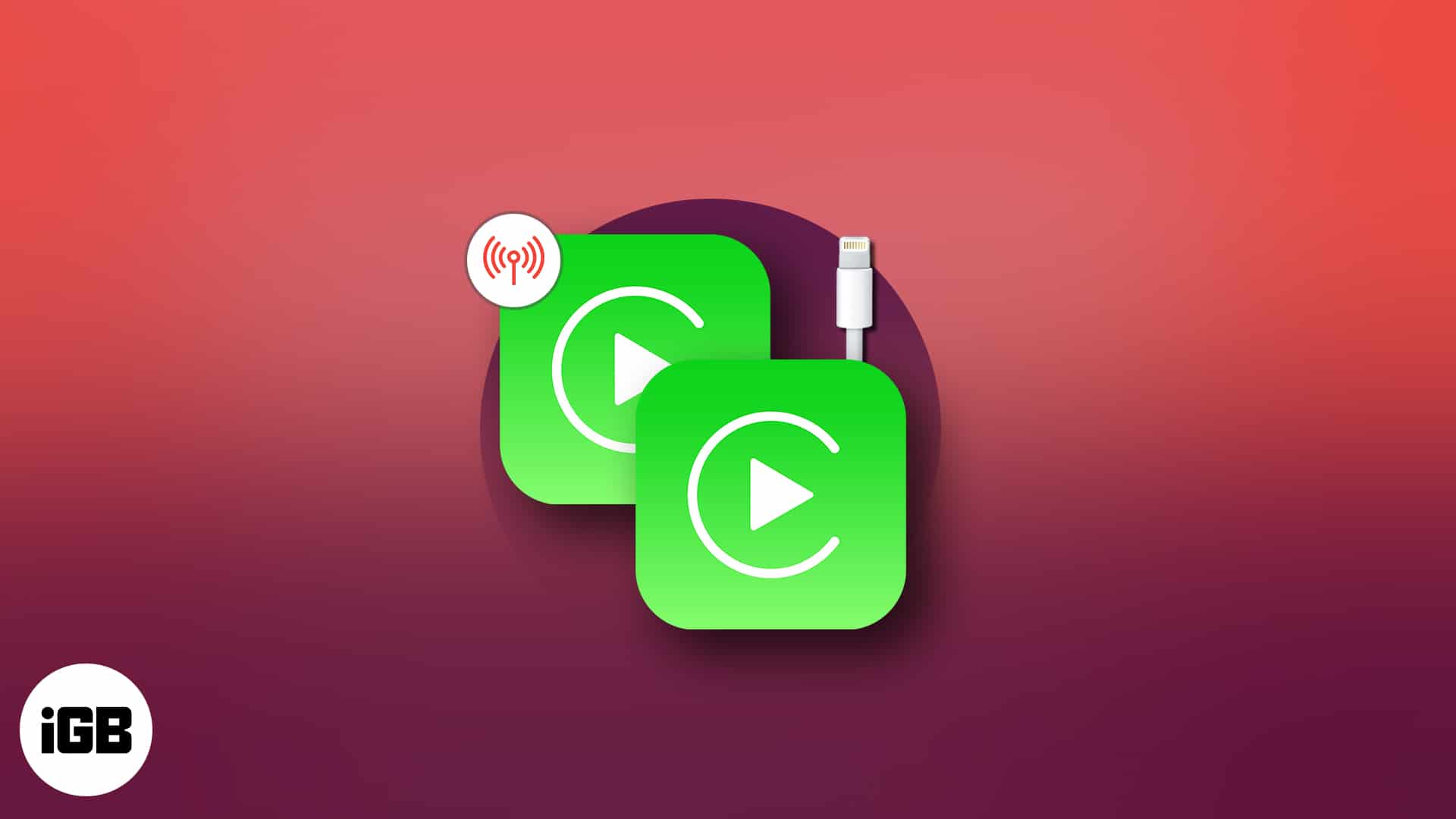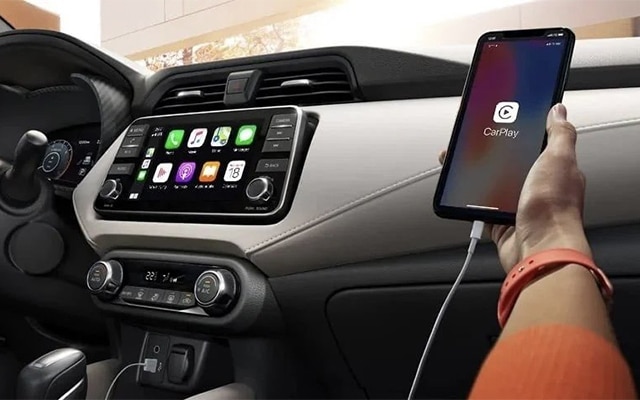Don’t use your phone while driving! You must be aware of this ‘must follow’ road safety protocol. Though abiding by this rule ensures your safety, it can put your urgent work at an abrupt stop. Apple knows this, and CarPlay is the solution crafted by the software giant to turn your frowns into broad smiles.

Apple CarPlay lets you access all your iPhone’s essential features and apps on the car’s infotainment display. You can call, text, control music, navigate, and do other things without looking away from the road.
CarPlay comes in two versions- wired and wireless. So, what’s better- Apple CarPlay Wireless or Wired? This article covers the key differences between wired and wireless CarPlay so that you can pick the right one for yourself.
Wired CarPlay – Advantages and disadvantages
Wired CarPlay continues to dominate the market irrespective of the launch of its wireless counterpart. Users consider it to be more convenient and efficient regarding usability and content streaming. Since its launch at WWDC 2013, wired CarPlay has been an essential and applauded part of the Apple ecosystem. The list below elaborates on the advantages and disadvantages of wired CarPlay. Do check it out.

Pros
Although the tech is a bit dated, it surely provides a lot more reliability. Let’s look at a few more advantages.
✅ Charge-on-the-go
In case you have a wired Apple CarPlay set up in your vehicle, you must plug your iPhone into the USB port using a lightning cable. It’s a straightforward option that’s seamlessly compatible with most cars. However, this simple-looking feature comes with the added advantage of iPhone charging.
When you start CarPlay by connecting your iPhone to the port, your smartphone will begin charging without external accessories. Moreover, as wired CarPlay requires cable plugging, the chances of you forgetting to charge your device while driving are low.
Further, wireless charging pads are limited to the top-tier and pricey car variants preferred by those with heavy wallets. Also, wireless charging is a big No-No if your iPhone has a thick phone case or worse- it does not support wireless charging. For all these situations, wired CarPlay is the ultimate rescue solution.
✅ Perfect audio and video sync
Bluetooth blesses you with seamless wireless connectivity. Over the years, Bluetooth has witnessed some significant upgrades. But unfortunately, it still falls flat compared to wired connections. These differences come alive in wired CarPlay. Cable connections ensure that the audio of your iPhone syncs perfectly with your car’s infotainment system.
The chance of time lags between audio and video are more prominent in wireless CarPlay connections. You must have experienced poor synchronization between the audio from your iPhone and car speakers and the video. Luckily, a wired CarPlay system saves you from these lags effectively. It ensures you enjoy content with synchronized audio and visuals during travel expeditions.
Support for Lossless Audio is also an essential feature of cable connections. With this, you can relish your favorite music in its purest form or at a higher quality. A perfect treasure for music lovers and a clean sweep for wired CarPlay in the wired vs. wireless CarPlay audio quality battle.
✅ Improved connectivity
A wired CarPlay connection offers better stability and continuity for your car’s speakers setup. A simple unplug-and-replug will bring your audio back and running for you in seconds. Managing network failures is easy with cable connections than compared to wireless variants. This is because most vehicles will restrain you from reconnecting when you are on the road.
The last thing you would be willing to do is to halt your journey and discover the reason for the network glitch. While connecting to Bluetooth is a feasible option, it won’t match the experience you get with CarPlay. Further, the problem tends to get worse when you are using CarPlay for navigation. Indeed, you won’t like to peek at the iPhone screen every time for directions and turns.
All these factors make wired CarPlay a perfect choice for you.
Cons
Although not many, it’s important to point out the disadvantages of Apple CarPlay.
❌ Lack of range
A limited usability range for iPhone is one of the significant drawbacks of wired CarPlay. For instance, if you plan to use your iPhone while enjoying music on CarPlay, the experience will be challenging.
Moreover, it might sometimes be difficult for you to locate the ports you are willing to connect your iPhone to as they remain hidden under the center console or compartments. Further, it complicates the use of the iPhone with CarPlay.
Another issue arises when you are traveling with your family and friends. Each of them has their preferences and a nudge to play their favorites. Certainly, unplugging and replugging your iPhone every time is quite cumbersome. Though a longer cable can fix this issue, it can get messy sometimes.
❌ Faulty wires
Wires are prone to go haywire. Okay, jokes apart. A cable can stop working abruptly without any heads-up. If this happens, your wired CarPlay will go OFF instantly, leaving you with a frown. Further, you must be lucky if plugging and replugging your iPhone brings the CarPlay back to working form. However, this cannot be a long-term solution.
Wireless CarPlay – Advantages and disadvantages
Wireless – as the name suggests, no cables are involved in this CarPlay variant. When you step into your car and start it, CarPlay’s innovative technology gets active. This convenience-to-work has encouraged brands like BMW, Ford, Honda, Mercedes-Benz, Nissan, Volkswagen, and others to adopt the wireless CarPlay version in their vehicles. Learn more about wireless CarPlay through the pros and cons mentioned here.

Pros
Wireless CarPlay offers a modern way of operating your iPhone apps from the car. That’s not the only benefit; there are a few more.
✅ Free range
With wireless CarPlay, you don’t have to plug in your iPhone. Thus, anyone accompanying you can take hold of your iPhone and play their music. No more fretting, phew! In addition, as you use CarPlay inside your car, the signal connectivity is at its peak. You won’t experience lags or breaks due to the powerful signal flow.
Further, wireless connectivity allows you to place your iPhone anywhere you want. For instance, you can put it inside your bags and skip impromptu drops from your lap or console. This also means you can quickly charge your iPhone in wired or wireless modes.
Become an iGeeksBlog Premium member and access our content ad-free with additional perks.
✅ Fast connectivity
Instant connectivity – your wireless CarPlay will bless you with just that. You don’t have to take time to plug the cable to start the process. Once you enable it, wireless CarPlay automatically connects to your car’s infotainment system.
Everything you need- apps and features- get ready for your access instantly. FYI, the loading speed relies on the quality of the processor installed by your car manufacturer. Whether scrolling through apps, tapping the touchscreen, or triggering Siri- you will love the intuitiveness of the feature. The lag-free experience will match the wired CarPlay.
✅ Battery icon displayed
Unlike wired CarPlay, the wireless version keeps you informed about the battery percentage of your iPhone. Irrespective of which app you are using, you can see the battery icon on the left side below the time and network icons.
The battery icon turns green when charging is ON, so you can always track the battery level with wireless adapters. The feature is helpful when your kids often fiddle with your iPhone, not letting it charge properly. Glancing the battery icon will inform you about the battery level, saving your iPhone and CarPlay from going off.
Cons
Wireless CarPlay surely provides ease and comfort, but it does have its share of cons too.
❌ Changing devices is a hassle
Fortunately, your car’s infotainment system allows you to save multiple devices to use with CarPlay. Now, if you are in the car and one of your friends wants to connect their device with CarPlay, switching can get messy with the wireless variant. Even if it is the other way around, it will be troublesome for you.
Firstly, you must disconnect your device from CarPlay. Next, your friend must work like Flash to connect their device to the system. If your friend fails to connect their device, your device will get reconnected to CarPlay. This process will move like a loop and get irritating after a few failed attempts. Turning on the Airplane Mode or switching off Bluetooth won’t work here.
❌ Unable to connect
Wireless CarPlay is fast and convenient. However, on a bright sunny day, your iPhone will throw tantrums and not connect to the CarPlay for no apparent reason. The system will prompt you to check your iPhone’s network, but you might not find one.
Connecting and reconnecting your iPhone from CarPlay or restarting your device or car won’t necessarily fix the issue. And this will leave you with nothing but frustration, which is undoubtedly bad for your health.
Note: Here is our guide on how to fix Apple CarPlay not working on iPhone. Please check it out.
❌ Lack of support
One of the most significant differences between wired and wireless CarPlay is the latter’s limited availability. You will be surprised to know that a majority of popular car brands like sticking with wired CarPlay support instead of wireless. The feature is unavailable even in the new-age modern cars housing advanced features.
In addition, the wireless CarPlay option is included only with the top-tier gradient of the car. This is one of the primary reasons for the popularity of wired CarPlay amongst users who prefer to buy the base model with wired CarPlay support. Moreover, due to the limited use of wireless CarPlay, Apple might take longer to fix its glitches for the people using it. Sad, but true.
Wireless vs. wired CarPlay – Same but different
Wired and wireless CarPlay are like two sides of the same coin. Both variants have a similar user interface, leaving everything to the users’ tastes, preferences, and purposes. While some infotainment systems will perform better with wired CarPlay, others might reach their full potential with wireless CarPlay.
Bestowing the winner’s title to the two CarPlay versions depends entirely on your preferences and use case. While wireless CarPlay leads in connectivity, the wired variant promises better audio and video flow. You can analyze the pros and cons mentioned in this article and pick your fit. Also, with a wireless CarPlay adapter, you can use wireless CarPlay in vehicles that don’t support it.
Moreover, Apple has added some amazing upgrades to its iPhone-supported software platform. CarPlay now has SharePlay support in the Music app, allowing your fellow passengers to control the music from their devices. Further, the Maps app on CarPlay will now provide information about real-time vehicle charging stations.
With CarPlay, you can enjoy all iPhone functionalities at your fingertips without diverting your eyes from the busy road. Whether you choose the wired or the wireless variant of CarPlay, you get the best of the Apple ecosystem. The portal keeps your work going and entertainment alive every time you are in your car. The fun never stops with Apple CarPlay!
FAQs
Yes, wireless CarPlay is slower than wired because the wireless adapter acts like a mediator between the iPhone and the CarPlay system.
Yes, wireless CarPlay is costlier than wired CarPlay.
Yes, you can use wireless CarPlay dongles to connect to the CarPlay USB port and turn a wired CarPlay into a wireless.
No, wired and wireless CarPlay cannot work together. If you connect your iPhone to your car’s USB port, CarPlay will auto-switch to wired mode. If you want to use wireless CarPlay, you must disconnect your iPhone from the USB port.
Read more:
